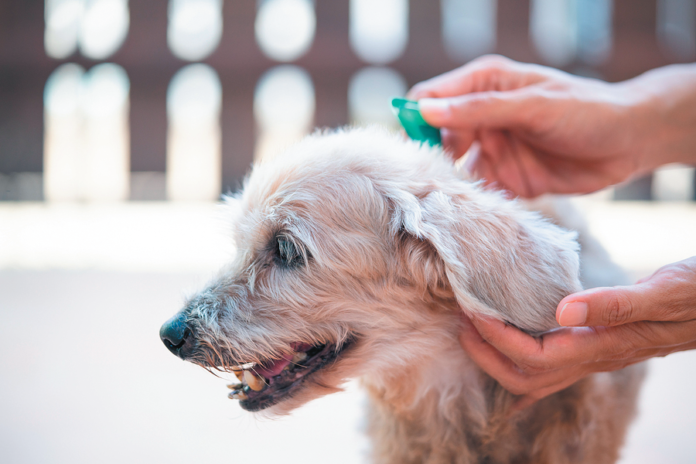It’s important to keep your dog protected from fleas and ticks all year round in order to prevent the transmission of infectious diseases from those two parasites, some of which can be very severe. But which product should you use? Herein, a guide to help you select the preventative that will best suit your dog.
Collar
Advantages. Collars are a good choice for those who don’t want to be on a monthly schedule of applying a topical between the shoulder blades or giving tablets by mouth, which some dogs hate. They last up to 6 to 8 months at a time. Additionally, they have a mosquito repellent, which can also provide for protection from infectious diseases such as Leishmaniasis.
Disadvantages. Collars are expensive compared to other options. And they can get lost. Additionally, bathing and swimming can reduce the duration of a collar’s effectiveness. Some brands recommend bathing no more than once a month. And a dog who is a frequent swimmer (more than once monthly) will not have the highest level of protection a collar can afford. Finally, some dogs experience temporary, mild dermatitis due to irritation of the collar at the application site. It can take up to two weeks for the discomfort to resolve (although you don’t have to remove the collar).
Some good brands. The Seresto collar protects against fleas and ticks for up to 8 months. It is also safe for cats — an important point for households that have both dogs and cats. (Cats are very sensitive to certain treatments commonly used for dogs.) Another very effective collar is Scalibor Protector Band. It provides up to 6 months of protection against fleas and ticks.
Topical
Advantages. Once you apply the medicine between the shoulder blades with a little pipette included in the package, you don’t have to worry that it will get lost, as you would with a collar. Topicals, or spot-ons, also tend to be less expensive than collars.
Disadvantages. The big disadvantage is for people who are not the best at sticking to a schedule. You need to apply the medication every 30 days in most cases, like clockwork. Protection really goes down in week five, and even more so in week six. Spot-ons can also present problems for people who bathe their dogs frequently, or for dogs that swim often. A dog should not be bathed for two days before or after application; the medicine won’t persist on the skin’s surface. There’s also a problem for dogs who are bathed a lot in general or go swimming several times a month. In fact, the water issue is bigger with topicals than collars. With a collar, the medication levels will come back up again after a couple of days; they’re slow-release. That’s not the case with the topicals.
Some good brands. K9 Advantix, Revolution, Frontline Plus, Activyl Tick Plus, Vectra 3D, and Bravecto. (With Brevecto, pets are covered for 2 months against ticks and 3 months against fleas.) All have been proven safe and effective with scientific studies published in peer-reviewed journals. That means independent researchers without a vested interest in the products checked the research results and looked for holes in the study designs before the conclusions were allowed to appear in academic publications. Some spot-ons are contraindicated for cats; it is important to make sure that the product you select is labeled okay for any cats who might be living in your home.
Note: Certain spot-ons come in the form of sprays. Their main advantage is that they are safe to use on very young animals (for example, a 4-week-old puppy) because they can be applied regardless of the dog’s weight. However, they must be sprayed daily and may not be as effective as spot-ons or pills.
Pills
Advantages. If you have a water-loving dog or one who needs frequent baths because of, say, a skin condition, pills are the way to go. They will never lose their potency due to the animal’s water exposure. Also, pills or tablets are good for those concerned about having an insecticide on their dog’s skin surface (because of close contact with children or other species of pets).
Disadvantages. Some dogs make the administration of pills pure hell. Neither wrapping a pill in cheese or salami nor gentle talk will work. Even using your hand to manually keep open the dog’s jaw can end in the dog’s spitting out the pill or simply letting it drop out of his mouth. If that describes your pet, pills are the wrong choice, even if your pet is often in the water. Note, too, that a very small minority of dogs react to the pills with vomiting or diarrhea — although reactions tend to be mild.
Some good brands. Bravecto is a pill to be given every 3 months against fleas and every 2 months against ticks, while Nexgard or Simparica call for once a month. Trifexis is also given monthly and covers heartworm and intestinal parasites as well as fleas. It doesn’t take care of ticks, however. You’ll need a separate product.






I’m not an anti-Western medicine nut. I do use thee products and want to keep using them. But how thorough is the testing for these products with regard to the short and long term health of the dog? Humans don’t ingest insecticides, but our dogs do. We also don’t spend all our time rolling in the grass, but I still wouldn’t want to ingest toxic chemicals on principle.